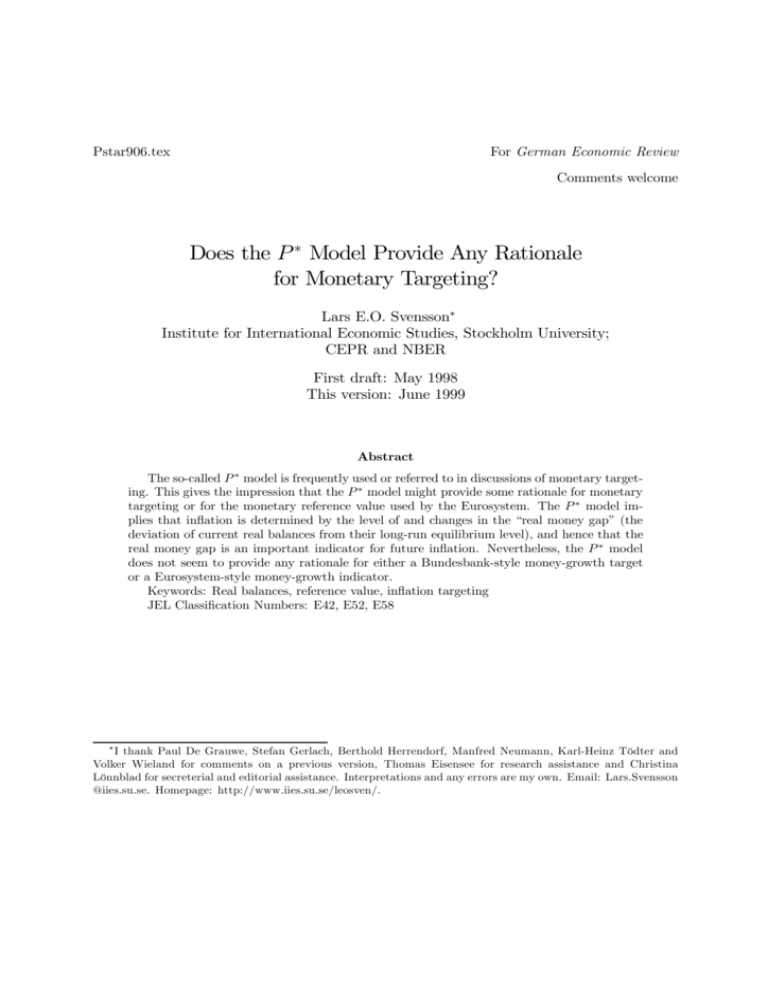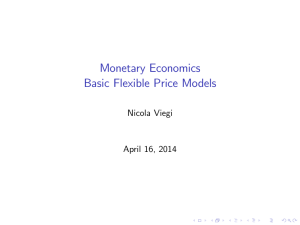Does the P# Model Provide Any Rationale for Monetary Targeting?
advertisement

Pstar906.tex For German Economic Review Comments welcome Does the P ¤ Model Provide Any Rationale for Monetary Targeting? Lars E.O. Svensson¤ Institute for International Economic Studies, Stockholm University; CEPR and NBER First draft: May 1998 This version: June 1999 Abstract The so-called P ¤ model is frequently used or referred to in discussions of monetary targeting. This gives the impression that the P ¤ model might provide some rationale for monetary targeting or for the monetary reference value used by the Eurosystem. The P ¤ model implies that in‡ation is determined by the level of and changes in the “real money gap” (the deviation of current real balances from their long-run equilibrium level), and hence that the real money gap is an important indicator for future in‡ation. Nevertheless, the P ¤ model does not seem to provide any rationale for either a Bundesbank-style money-growth target or a Eurosystem-style money-growth indicator. Keywords: Real balances, reference value, in‡ation targeting JEL Classi…cation Numbers: E42, E52, E58 ¤ I thank Paul De Grauwe, Stefan Gerlach, Berthold Herrendorf, Manfred Neumann, Karl-Heinz Tödter and Volker Wieland for comments on a previous version, Thomas Eisensee for research assistance and Christina Lönnblad for secreterial and editorial assistance. Interpretations and any errors are my own. Email: Lars.Svensson @iies.su.se. Homepage: http://www.iies.su.se/leosven/. 1. Introduction The so-called P ¤ model (see Hallman, Porter and Small [14]) is often used (or at least referred to) in discussions of monetary targeting (for instance, in Jahnke and Reimers [17], Neumann [21], Tödter and Reimers [27], Tödter and Ziebarth [28] and von Hagen [29]). This may give the impression that the P ¤ model provides some rationale for money-growth targeting, especially since the P ¤ model seems to be part of the Bundesbank’s view of the transmission mechanism of monetary policy, see Jahnke and Reimers [17]. This short paper examines whether the P ¤ model indeed provides any such rationale. Furthermore, in its monetary strategy, the Eurosystem has given a prominent role to a money-growth indicator, the deviation of current M3 growth from a speci…ed reference value, as an indicator of “threats to price stability” (see ECB [9]-[11]). Using conventional aggregatesupply and aggregate-demand relations, Svensson [26] has argued that this money-growth indicator is likely to be an inferior indicator of such threats, and that an in‡ation forecast is instead the natural indicator. This paper also examines whether the P ¤ model provides any support for the Eurosystem money-growth indicator. The main result of the paper is that, although the P ¤ model gives a prominent role to real balances in forecasting in‡ation and, hence, to a “real money gap” as an important indicator, it does not provide any support for either a Bundesbank-style money-growth target or a Eurosystem-style money-growth indicator. Section 2 presents a slight generalization of the basic P ¤ model. Section 3 relates in‡ation and real balances. Section 4 derives in‡ation forecasts for the P ¤ model. Section 5 speci…es a money-demand function. Section 6 compares in‡ation targeting and money-growth targeting. Section 7 discusses the reaction functions that follow from the two kinds of targeting. Section 8 presents the conclusions. 2. The P ¤ model De…ne (log) velocity vt by the quantity equation, vt ´ pt + yt ¡ mt ; (2.1) where pt , yt and mt are the (logs of the) price level, output and (nominal) money, respectively, in period t. 1 Consider a long-run equilibrium with (log) output equal to (log) potential output, yt¤ ; velocity equal to long-run equilibrium (log) velocity, vt¤ , and the (log) price level equal to a long-run equilibrium level (for a given stock of money, mt ), p¤t , given by p¤t ´ vt¤ ¡ yt¤ + mt : (2.2) Furthermore, in line with the P ¤ literature, make the assumption that the in‡ation dynamics are given by ¼t = (1 ¡ ®¢p )¼ t¡1 + ®¢p ¢p¤t¡1 ¡ ®p (pt¡1 ¡ p¤t¡1 ) + "t ; (2.3) where ¼t ´ pt ¡ pt¡1 ; 0 · ®¢p · 1, ®p > 0, ¢p¤t ´ p¤t ¡ p¤t¡1 , and "t is an iid shock with zero mean. Equation (2.3) for given ®¢p is a slight generalization of the P ¤ model. Hallman, Porter and Small [14] assumes (2.3) with ®¢p = 0. Tödter and Reimers [27] assume a variant of (2.3) with ®¢p = 1. Neumann [21] also assumes a variant of (2.3) with ®¢p = 1; but with the variables on the right side all dated t. Thus, according to (2.3), in‡ation is determined by lagged in‡ation, ¼t¡1 , lagged P ¤ in‡ation, ¢p¤t¡1 , and the lagged “price gap,” pt¡1 ¡ p¤t¡1 . 3. In‡ation and the real money gap I …nd it instructive to express (2.3) in terms of real balances. First, note that pt ¡ p¤t ´ ¡ mt + pt + mt ¡ p¤t ´ ¡ (m ~t ¡m ~ ¤t ); (3.1) ~ ¤t ´ mt ¡ p¤t is long-run equilibrium (log) real where m ~ t ´ mt ¡ pt is (log) real balances and m balances, which by (2.2) ful…ll m ~ ¤t ´ ¡ vt¤ + yt¤ : (3.2) ~ ¤t . Thus, the price gap is the negative of the “real money gap,” m ~t ¡m ~t ¡m ~ ¤t ), we can write (2.3) as Then, using (3.1) and ¢p¤t ´ ¼t + ¢(m ~ t¡1 ¡ m ~ ¤t¡1 ) + ®¢m ¢(m ~ t¡1 ¡ m ~ ¤t¡1 ) + "t ; ¼t = ¼t¡1 + ®m (m (3.3) where ®m ´ ®p and ®¢m ´ ®¢p . ~ ¤t¡1 and Thus, in‡ation depends on lagged in‡ation, the lagged real money gap, m ~ t¡1 ¡ m ~ t¡1 ¡ m ~ ¤t¡1 ). Compared to when ®¢m > 0; also on the change in the lagged real money gap, ¢(m conventional backward-looking Phillips curves, where in‡ation depends on lagged in‡ation and 2 the output gap, the real money gap simply replaces the output gap. Thus, whereas the discussion about money as an indicator has often centered on the role of real balances for aggregate demand and output (see Meltzer [20]), the P ¤ model puts real balances …rmly in the in‡ation equation. 4. In‡ation forecasts Let us now consider in‡ation forecasts in the P ¤ model. By (3.3), the one-period-ahead in‡ation forecast can be written ~t ¡m ~ ¤t ) + ®¢m ¢(m ~t ¡m ~ ¤t ); ¼t+1jt = ¼t + ®m (m (4.1) where, for any variable x; xt+¿ jt ´ Et xt+¿ denotes the forecast of xt+¿ conditional on information available in period t. Furthermore, by solving (4.1) backwards, we can express the T -periodahead in‡ation forecast, ¼t+T jt , as ¼t+T jt = ¼t + ®m TX ¡1 ¿ =0 (m ~ t+¿ jt ¡ m ~ ¤t+¿ jt ) + ®¢m [(m ~ t+T ¡1jt ¡ m ~ ¤t+T ¡1jt ) ¡ (m ~ t¡1 ¡ m ~ ¤t¡1 )]: (4.2) Thus, the T -period-ahead in‡ation forecast depends on current in‡ation in period t, the forecast of the sequence of real money gaps from period t to t + T ¡ 1; and the forecast of the change in real money gap from period t ¡ 1 to period t + T ¡ 1. 5. Money demand The money stock in the P ¤ model is broad money, typically M2 or M3. This is an endogenous variable, imperfectly controlled by the central bank. Similarly, the real money gap is an endogenous variable that can only be imperfectly controlled by the central bank. In practice, the central bank’s control over broad money is exercised via control of a short interest rate which then a¤ects the demand for broad money. In turn, the central bank’s control over short interest rates is exercised via control over the nonborrowed monetary base, or some component of the nonborrowed monetary base. For practical purposes, it is su¢cient to regard a short nominal interest rate as the central bank’s instrument. Money is then an endogenous variable, determined by money demand. Consider a reasonably realistic money-demand function, the error-correction form ~ t¡1 ¡ ·y yt¡1 + ·i it¡1 ) + ·1 ¢m ~ t¡1 + µt ; ¢m ~ t = ¡ ·m ( m 3 (5.1) where ·m ; ·y ; ·i > 0, ·1 ¸ 0, it is the short nominal interest rate in period t and the central bank’s instrument, and µt is an iid money-demand shock with zero mean. This money-demand function implies a long-run money-demand function equal to m ~ t = ·y yt ¡ ·i it ; (5.2) where ·y is the long-run elasticity of real balances with respect to output and ·i the longrun semi-elasticity with respect the interest rate. In the short run, demand for real balances adjusts to the discrepancy between lagged real balances, m ~ t¡1 , and the long-run real balances, ~ t¡1 . Since real balances react ·y yt¡1 ¡ ·i it¡1 , and to the change in lagged real balances, ¢m with a lag to the central bank’s instrument and real balances are also subject to shocks after the instrument is set, the central bank then only has imperfect control over money.1 With this money-demand equation, long-run equilibrium real balances are given by m ~ ¤t ´ ·y yt¤ ¡ ·i i¤ ; (5.3) where potential output, yt¤ , and the long-run equilibrium interest rate, i¤ , are substituted into the long-run money-demand equation (5.2). Here, the long run equilibrium interest rate is given by ^; i¤ ´ r¤ + ¼ (5.4) where r¤ is the long-run equilibrium level of the real interest rate and ¼ ^ is an in‡ation target ^ , and hence ¼ ^ , are here assumed to and the long-run equilibrium in‡ation rate. Both r¤ and ¼ be constant.2 It follows from (5.1) that velocity is given by vt ´ yt ¡ m ~ t = yt ¡ m ~ t¡1 + ·m (m ~ t¡1 ¡ ·y yt¡1 + ·i it¡1 ) ¡ ·1 ¢m ~ t¡1 ¡ µt ; (5.5) whereas the long-run equilibrium velocity is given by vt¤ = (1 ¡ ·y )yt¤ + ·i i¤ : (5.6) The long-run equilibrium price level, p¤t , is then given by p¤t = ¡ ·y yt¤ + ·i i¤ + mt : (5.7) 1 See Browne, Fagan and Henry [3] for a survey of European money-demand functions. This money-demand function is estimated and used by Rudebusch and Svensson [22] in discussing the performance of monetary targeting in the U.S. It is estimated for Euro-area data by Gerlach and Svensson [13]. 2 If there is a trend ¢y ¤ in yt¤ and/or a trend ¢i¤ in i¤t (the latter due to a trend in rt¤ and/or ¼ ^ t ), the equation ~ t¡1 ¡ ·y yt¡1 + ·i it¡1 ) + ·1 ¢m ~ t¡1 + µt ; where the constant is (5.1) should include a constant, ¢m ~ t = ·0 ¡ ·m (m given by ·0 = (·y ¢y¤ ¡ ·i ¢i¤ )=(1 ¡ ·1 ). In order to reduce clutter, this constant has been deleted. 4 6. Strict in‡ation targeting and the money-growth target or indicator Consider now the simple case of “strict” in‡ation targeting, when the central bank’s only objective is to stabilize in‡ation around the in‡ation target, ¼ ^ .3 With the above money-demand equation, the central bank can a¤ect real balances in period t + 1; by setting the instrument in period t. By (3.3), real balances in period t + 1 a¤ects in‡ation in period t + 2. Clearly, the optimal policy under strict in‡ation targeting is then to set the interest rate such that the twoperiod-ahead in‡ation forecast, ¼t+2jt ; conditional on information available in period t, equals the in‡ation target, ^. ¼t+2jt = ¼ (6.1) By leading (4.1) one period and taking expectations in period t, we get the two-period-ahead in‡ation forecast as ~ t+1jt ¡ m ~ ¤t+1jt ) + ®¢m ¢(m ~ t+1jt ¡ m ~ ¤t+1jt ): ¼t+2jt = ¼t+1jt + ®m (m (6.2) Combining (6.1) and (6.2) and solving for m ~ t+1jt gives m ~ t+1jt = m ~ ¤t+1jt ¡ 1 ®¢m (¼t+1jt ¡ ¼ ^) + (m ~t ¡m ~ ¤t ): ®m + ®¢m ®m + ®¢m (6.3) The right side of (6.3) is a forecast of the state-dependent level of real balances in period t+1 that is consistent with strict in‡ation targeting. We can interpret this as a conditional intermediate target for real balances in period t + 1. Let us express (6.3) as a conditional intermediate target for nominal money-growth, ~ t+1jt + ¼t+1jt ¢mt+1jt ´ ¢m 1 ¡ ®m ¡ ®¢m ®m = ¼ ^ + ¢m ~ ¤t+1jt ¡ (¼t+1jt ¡ ¼ ^) ¡ (m ~t ¡m ~ ¤t ): ®m + ®¢m ®m + ®¢m (6.4) Thus, we can de…ne d ´¼ ¢m ^ + ¢m ~ ¤t+1jt ¡ t+1jt 1 ¡ ®m ¡ ®¢m ®m (¼ t+1jt ¡ ¼ ^) ¡ (m ~t ¡m ~ ¤t ) ®m + ®¢m ®m + ®¢m (6.5) as a conditional nominal money-growth target that is consistent with strict in‡ation targeting. This money-growth target is “conditional” in the sense that it depends on the current and lagged state of the economy, more precisely the deviation between the one-period-ahead in‡ation 3 As inP Svensson [25] and [24], by strict in‡ation targeting I mean minimizing an intertemporal loss function, 1 Et (1 ¡ ±) ¿ =0 ± ¿ Lt+¿ , where 0 < ± < 1 is a discount factor and the period loss is given by Lt = 12 (¼ t ¡ ¼ ^ )2 . That is, in‡ation is the only variable entering the loss function. 5 forecast (which is predetermined under (3.3) and (5.1) and cannot be a¤ected by the central ~ ¤t . ~t ¡m bank) and the current real money-gap, m Let us now contrast this conditional money-growth target with the Bundesbank moneygrowth target, or the Eurosystem reference value for money growth. Until Germany joined the EMU, each December, Bundesbank calculated its money-growth target for the coming year, as the sum of an in‡ation target (over the years called “unavoidable in‡ation,” “normative” in‡ation or “medium-term price assumption”), a forecast of potential output growth, less an estimated velocity trend. The Eurosystem currently calculates its reference value for M3 growth in the same way (see European Central Bank [10]). Thus, the Bundesbank money-growth target and the Eurosystem reference value, ¢m¤t+1jt , are given by ¤ ¤ ^ + ¢yt+1jt ¡ ¢vt+1jt ´¼ ^ + ¢m ~ ¤t+1jt ; ¢m¤t+1jt = ¼ (6.6) where we have used (3.2).4 This is an “unconditional” money-growth target, in the sense that it only depends on potential output growth and the velocity trend, which from the point of view of monetary policy are either exogenous or change only slowly with the current state of the economy. It follows that the discrepancy between the conditional money-growth target (6.5) and the unconditional money-growth target (6.6) is given by d ¡ ¢m¤ ¢m t+1jt t+1jt = ¡ 1 ¡ ®m ¡ ®¢m ®m (¼t+1jt ¡ ¼ ^) ¡ (m ~t ¡m ~ ¤t ): ®m + ®¢m ®m + ®¢m This discrepancy can be interpreted in two ways. First, it shows that there is a tradeo¤ between stabilizing in‡ation around the in‡ation target ¼ ^ and stabilizing money-growth around the unconditional money-growth target (6.6). Thus, minimizing in‡ation variability around the in‡ation target would require a variable conditional money-growth target and generally lead to higher than minimum variability of money-growth. Minimizing money-growth variability around an unconditional money-growth target would generally lead to higher than minimum variability of in‡ation. The tradeo¤ between stabilizing in‡ation and stabilizing money-growth is empirically estimated for U.S. data in Rudebusch and Svensson [22] and found to be substantial. Second, the discrepancy shows that the Eurosystem money-growth indicator, ¢mt ¡ ¢m¤tjt¡1 ; 4 (6.7) This is a simpli…cation, in order to reduce clutter. If the period is a quarter, the money-growth target is ¤ ¤ ¢4 m¤t+4jt = 4^ ¼ + ¢4 yt+4jt ¡ ¢4 vt+4jt ´ 4^ ¼ + ¢4 m ~ ¤t+4jt ; where ¢4 xt ´ xt ¡ xt¡4 . 6 the deviation of current money-growth from the reference value,5 is likely to be an inferior indicator of future in‡ation deviations from the in‡ation target. This can be seen more directly by expressing the deviation of the two-period-ahead in‡ation forecast from the in‡ation target ^ from (6.2) and rewriting gives as a function of this money-growth indicator. Subtracting ¼ ^ = ¼t+1jt ¡ ¼ ^ ¡ (®m + ®¢m )¢m ~ ¤t+1jt + ®m (m ~t ¡m ~ ¤t ) + (®m + ®¢m )¢m ~ t+1jt : ¼t+2jt ¡ ¼ ~ t , and Taking expectations of (5.1), substituting for ¢m ~ t+1jt , collecting all terms involving ¢m replacing ¢m ~ t by ¢mt ¡ ¼t then gives, after some algebra, ^ = ¼t+1jt ¡ ¼ ^ ¡ (®m + ®¢m )¢m ~ ¤t+1jt ¡ ®m m ~ ¤t + (®m + ®¢m )·m (·y yt ¡ ·i it ) ¼t+2jt ¡ ¼ ~ t¡1 ¡ [®m + (®m + ®¢m )(·1 ¡ ·m )](¼t ¡ ¢m¤tjt¡1 ) + [®m ¡ (®m + ®¢m )·m ]m +[®m + (®m + ®¢m )(·1 ¡ ·m )](¢mt ¡ ¢m¤tjt¡1 ): (6.8) Here the last term in (6.8) isolates the e¤ect of the current money-growth indicator, (6.7), on the deviation of the two-period-ahead in‡ation forecast from the in‡ation target. It seems fairly obvious that the relation between that deviation and the money-growth indicator is tenuous, to say the least. The in‡ation forecast is a¤ected by much more than the money-growth indicator. At least, the sign of this e¤ect is likely to be positive, though, since empirically 0 < ·m < ·1 is typical. Thus, using the money-growth indicator as indicating deviations of the in‡ation forecast from the in‡ation target disregards the other determinants of the in‡ation forecast in (6.8). Furthermore, the partial e¤ect of the indicator may even be negative. Thus, the money-growth indicator is likely to be a misleading indicator of “risks to price stability.” Instead, as argued in Svensson [26], the best indicator of such risks seems to be the deviation between the two-periodahead in‡ation forecast and the in‡ation target for unchanged interest rate, it = it¡1 . This deviation then indicates deviations from the in‡ation target unless the instrument is changed. 7. Reaction functions Finally, let us note what the reaction functions for the short interest rate are under strict in‡ation targeting and strict money-growth targeting with the Buba-style money-growth target (6.6).6 5 Again, this is a simpli…cation to reduce clutter. If the period is a quarter, the money-growth indicator can be written as ¢4 mt ¡ ¢4 m¤tjt¡4 , or rather, to judge from Eurosystem announcements, as a three-month moving average of this expression. 6 d Strict money-growth targeting with a money-growth target ¢ mt means minimizing an intertemporal loss d mt )2 . That is, money growth function as in footnote 3 but with a period loss function given by Lt = 12 (¢mt ¡ ¢ is the only variable entering the loss function. 7 Under the P ¤ model, summarized by (2.3) or (3.3), these reaction functions clearly depend on the assumed money-demand function, (5.1). Leading (5.1) one period, taking expectations in period t, and solving for it gives it = ·y 1 ·1 1 yt ¡ m ~t + ¢m ~t ¡ ¢m ~ t+1jt : ·i ·i ·m ·i ·m ·i (7.1) d ¡¼ Replacing ¢m ~ t+1jt by ¢m t+1jt t+1jt and using (6.5) then gives the reaction function under strict in‡ation targeting, it = 1 (¼t+1jt ¡ ¼ ^) + ·y yt ·i ·m ·i (®m + ®¢m ) 1 ·1 1 ®m (m ~t ¡m ¡ m ~t + ¢m ~t ¡ ¢m ~ ¤t+1jt + ~ ¤t ) ·i ·m ·i ·m ·i ·m ·i (®m + ®¢m ) (7.2) Replacing ¢m ~ t+1jt by ¢m¤t+1jt ¡ ¼t+1jt and using (6.6) instead gives the reaction function under strict money-growth targeting, it = 1 ·y 1 ·1 1 (¼ t+1jt ¡ ¼ ^ ) + yt ¡ m ~t + ¢m ~t ¡ ¢m ~ ¤t+1jt ; ·m ·i ·i ·i ·m ·i ·m ·i (7.3) which, of course, is di¤erent from that under strict in‡ation targeting. Note that strict in‡ation targeting does generally not result in a reaction function like it = i¤ + °(¼t ¡ ¼ ^) or it = i¤ + °(¼t+1jt ¡ ¼ ^ ). Similarly, strict money-growth targeting does generally not imply a reaction of (or similar to) the form it = i¤ + °(¢mt ¡ ¢m¤tjt¡1 ): This illustrates the general principle that it is better to respond to the determinants of the target variables than to the target variables themselves, see Svensson [23]. 8. Conclusions Let us now summarize the conclusions for targeting a Bundesbank-style money-growth target and using a Eurosystem-style money-growth indicator from this examination of the P ¤ model. First, we have noticed that, for the P ¤ model, in‡ation depends on lagged in‡ation and the level of and changes in the lagged real money gaps, the di¤erence between real balances and 8 long-run equilibrium real balances. Thus, as shown in (6.2), the one-period-ahead in‡ation forecast depends on current in‡ation and the current level of and changes in the real money gap. Similarly, the T -period-ahead in‡ation forecast depends on current in‡ation, the forecast of the sequence of future real money gaps, and the forecast of the change in the real money gap during the forecast horizon. Thus, the P ¤ model assigns a dominant role to the real money gap in forecasting in‡ation. Nevertheless, this does not provide any rationale for targeting a Bundesbank-style nominal money-growth target (where the money-growth target is set as the sum of an in‡ation target and a forecast of potential output growth, less an estimated velocity trend). Stabilization of in‡ation around an in‡ation target instead requires a conditional money-growth target, (6.5), which deviates from the Bundesbank-style money-growth target, depending on the deviation of current in‡ation from the in‡ation target and the lagged real money gap. Thus, it follows that the P ¤ model does not give any rationale for the Eurosystem-style money-growth indicator either. Indeed, for stabilizing in‡ation around the in‡ation target, it is optimal to allow money-growth to deviate from the reference-value most of the time. The current money-growth indicator seems to be an inferior indicator of future in‡ation deviations from the in‡ation target. The reaction function corresponding to strict in‡ation targeting (which minimizes the variability of in‡ation and leads to larger than minimum variability of money growth) will obviously di¤er from that corresponding to targeting a Bundesbank-style money-growth target (which minimizes the variability of money-growth but leads to a larger than minimum variance of in‡ation). Although the discussion in this paper has been in terms of strict in‡ation targeting (without any weight on output gap stabilization), it is fairly obvious that the conclusions about the P ¤ model not providing any rationale for monetary targeting or a money-growth indicator will also hold under more realistic “‡exible” in‡ation targeting, where the loss function also includes some weight on the variability of the output gap.7 As far as I know, there is little theoretical support for the P ¤ model. The empirical support is mixed (see Christiano [6]). Gerlach and Svensson [13] …nd considerable empirical support for the P ¤ model for the Euro-area, but no support for the U.S. Even if the P ¤ model turned out to be a good description of in‡ation dynamics and the transmission mechanism of monetary policy 7 A previous version of this paper also examined ‡exible in‡ation targeting and con…rmed this statement. This requires the speci…cation of how output is determined. 9 for the Euro area, it would still not imply that targeting a Bundesbank-style money-growth target or relying on a European-style money-growth indicator would be appropriate. The recent interest in monetary targeting is mainly motivated by the view that monetary targeting is the reason behind Bundesbank’s outstanding record on in‡ation control and the possibility that the Eurosystem would choose monetary targeting as its monetary-policy strategy. However, with regard to whether monetary targeting lies behind Bundesbank’s success, as discussed in Svensson [26] for instance, a number of studies of Bundesbank’s monetary policy, by both German and non-German scholars, have come to the unanimous conclusion that, in the frequent con‡icts between stabilizing in‡ation around the in‡ation target and stabilizing money-growth around the money-growth target, Bundesbank has consistently given priority to the in‡ation target and disregarded the monetary target.8 Thus, Bundesbank has actually been an in‡ation targeter in deeds and a monetary targeter in words only. Furthermore, although the Eurosystem has adopted a money-growth indicator, it has strongly rejected monetary targeting as a suitable strategy, on the grounds that the relations between prices and money may not be su¢ciently stable and that the monetary aggregates with the best stability properties may not be su¢ciently controllable (see Issing [16]). Furthermore, an extensive and convincing discussion some 25 years ago concluded that intermediate monetary targeting was generally inferior; see, for instance, Kareken, Muench and Wallace [18], Friedman [12] and Bryant [5].9 Thus, whereas money-growth targeting is currently hardly a relevant alternative monetary policy, the Eurosystem gives considerable emphasis in its rhetoric, although, so far, not in its practice, to the money-growth indicator, as an indicator of “threats to price stability.” Svensson [26], using conventional aggregate supply and aggregate demand equations, has demonstrated that the money-growth indicator is likely to be an inferior indicator of such threats, and that an in‡ation forecast is instead the best indicator. Assuming instead the P ¤ model, the present paper arrives at the same conclusions. Rudebusch and Svensson [22] examine the consequences of monetary targeting in an empirical 8 This literature includes Neumann [21], von Hagen [29], Bernanke and Mihov [2], Clarida and Gertler [8], Clarida, Gali and Gertler [7] (note a crucial typo: the coe¢cient for money supply in Table 1 should be 0.07 instead of 0.7), Laubach and Posen [19], and Bernanke, Laubach, Mishkin and Posen [1]. 9 A separate argument for monetary targeting is that it would be preferable when there is considerable model uncertainty. Indeed, Brunner and Meltzer [4] argue that monetary targeting would minimize the maximum loss when there is considerable model uncertainty. (This is an interesting early example of an argument involving “robust control”, a minmax approach to optimal control recently discussed by Hansen and Sargent [15].) The Brunner-Meltzer argument remains to be examined rigorously. Furthermore, in practice there seem to be su¢cient information about the transmission mechanism for monetary policy to be able to do better than monetary targeting. For example, Bundesbank’s deliberate deviations from strict monetary targeting and success in in‡ation control is strong evidence of this. 10 model of in‡ation, output and money for the U.S. They …nd that monetary targeting in the U.S. would be quite ine¢cient, in the sense of causing high variability of both in‡ation and the output gap. They also show that this would, counter to conventional wisdom, also be the case if money demand were completely stable. Gerlach and Svensson [13] examine the empirical indicator properties of monetary aggregates for the Euro area. They …nd substantial empirical support for the real money gap as an indicator for future in‡ation, but little support for the nominal money-growth indicator. 11 References [1] Bernanke, Ben S., Thomas Laubach, Frederic S. Mishkin, and Adam S. Posen (1998), In‡ation Targeting: Lessons from the International Experience, Princeton University Press. [2] Bernanke, Ben S., and Ilian Mihov (1997), “What Does the Bundesbank Target?” European Economic Review 41, 1025-1054. [3] Browne, F.X., G. Fagan, and J. Henry (1997), “Money Demand in EU Countries: A Survey,” Sta¤ Paper No. 7, European Monetary Institute. [4] Brunner, Karl, and Allan H. Meltzer (1969), “The Nature of the Policy Problem,” in Karl Brunner, ed., Targets and Indicators of Monetary Policy, Chandler, San Francisco, 1–26. [5] Bryant, Ralph C. (1980), Money and Monetary Policy in Interdependent Nations, Brookings Institution, Washington D.C. [6] Christiano, Lawrence C. (1989), “P ¤ Is Not the In‡ation Forecaster’s Holy Grail,” Federal Reserve Bank of Minneapolis Quarterly Review 13 (Fall 1989), 3–18. [7] Clarida, Richard, Jordi Gali and Mark Gertler (1998a), “Monetary Policy Rules in Practice: Some International Evidence,” European Economic Review 42, 1033–1067. [8] Clarida, Richard, and Mark Gertler (1997), “How the Bundesbank Conducts Monetary Policy,” in Romer, Christina, and David Romer, eds., Reducing In‡ation: Motivation and Strategy, Chicago University Press. [9] European Central Bank (1998a), “A Stability-Oriented Monetary Policy Strategy for the ESCB,” Press Release, October 13, 1998, http://www.ecb.int. [10] European Central Bank (1998b), “The Quantitative Reference Value for Monetary Growth,” Press Release, December 1, 1998, http://www.ecb.int. [11] European Central Bank (1999), “The Stability-Oriented Monetary Policy Strategy of the Eurosystem,” ECB Monthly Bulletin, January 1999, http://www.ecb.int, 39–50. [12] Friedman, Benjamin M. (1975), “Targets, Instruments, and Indicators of Monetary Policy,” Journal of Monetary Economics 1, 443–473. 12 [13] Gerlach, Stefan, and Lars E.O. Svensson (1999), “In‡ation and Money in the Euroa Area: A Case for Monetary Indicators?” in preparation. [14] Hallman, Je¤rey J., Richard D. Porter, and David H. Small, (1991), “Is the Price Level Tied to the M2 Monetary Aggregate in the Long Run?,” American Economic Review 81, 841-858. [15] Hansen, Lars P., and Thomas J. Sargent (1998), “Alternative Representations of Discounted Robust Linear Quadratic Control,” Working Paper. [16] Issing, Otmar (1998), “The European Central Bank at the Eve of EMU,” speech in London, November 26, 1998. [17] Jahnke, Wilfried, and Hans-Eggert Reimers (1995), “The Transmission of Monetary Policy in the Econometric Model of the Deutsche Bundesbank for the German Economy,” in Financial Structure and the Monetary Policy Transmission Mechanism, Bank for International Settlements, Basle. [18] Kareken, John H., Thomas Muench, and Neil Wallace (1973), “Optimal Open Market Strategy: The Use of Information Variables,” American Economic Review 63, 156–172. [19] Laubach, Thomas, and Adam S. Posen (1997), Disciplined Discretion: Monetary Targeting in Germany and Switzerland, Essays in International Finance, No. 206, Princeton University. [20] Meltzer, Allan H. (1999), “The Transmission Process,” presented to the Deutsche Bundesbank Conference on The Monetary Transmission Process: Recent Developments and Lessons for Europe, March 1999. [21] Neumann, Manfred (1997), “Monetary Targeting in Germany,” in Kuroda, Iwai, ed., Towards More E¤ective Monetary Policy, Mcmillan, London. [22] Rudebusch, Glenn D., and Lars E.O. Svensson (1999), “Eurosystem Monetary Targeting: Lessons from U.S. Data,” Working Paper. [23] Svensson, Lars E.O. (1999a), “Better to Respond to Determinants of Targets than to Targets Themselves,” in preparation. 13 [24] Svensson, Lars E.O. (1999b), “In‡ation Targeting as a Monetary Policy Rule,” Journal of Monetary Economics, forthcoming. [25] Svensson, Lars E.O. (1999c), “In‡ation Targeting: Some Extensions,” Scandinavian Journal of Economics, forthcoming. [26] Svensson, Lars E.O. (1999d), “Monetary Policy Issues for the Eurosystem,” CarnegieRochester Series on Public Policy, forthcoming. [27] Tödter, Karl-Heinz, and Hans-Eggert Reimers (1994), “P -Star as a Link between Money and Prices in Germany,” Weltwirtschaftliches Archiv 130, 273–289. [28] Tödter, Karl-Heinz, and Gerhard Ziebarth (1997), “Price Stability vs. Low In‡ation in Germany: An Analysis of Costs and Bene…ts,” NBER Working Paper No. 6150. [29] von Hagen, Jürgen (1995), “In‡ation and Monetary Targeting in Germany,” in Leiderman, Leonardo, and Lars E.O. Svensson, eds. (1995), In‡ation Targets, Centre of Economic Policy Research, London. 14


![Achieving E[value]ation Report](http://s3.studylib.net/store/data/006808360_1-40d3ffcf3d52fbcd99b9919bdaf1a5ab-300x300.png)



